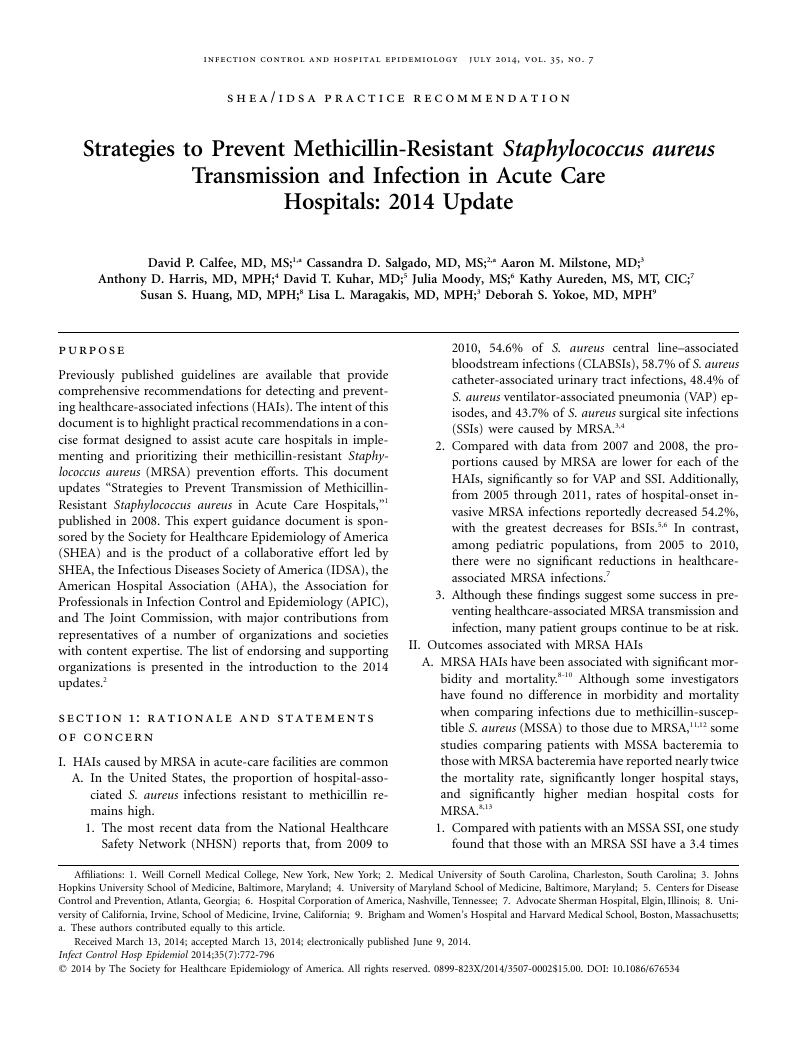Crossref Citations
This article has been cited by the following publications. This list is generated based on data provided by Crossref.
Barnett, Adrian G.
Page, Katie
Campbell, Megan
Brain, David
Martin, Elizabeth
Winters, Shirley
Hall, Lisa
Paterson, David
and
Graves, Nicholas
2014.
Changes in healthcare-associated infections after the introduction of a national hand hygiene initiative.
Healthcare infection,
Vol. 19,
Issue. 4,
p.
128.
Septimus, Edward
Weinstein, Robert A.
Perl, Trish M.
Goldmann, Donald A.
and
Yokoe, Deborah S.
2014.
Approaches for Preventing Healthcare-Associated Infections: Go Long or Go Wide?.
Infection Control & Hospital Epidemiology,
Vol. 35,
Issue. 7,
p.
797.
Yokoe, Deborah S.
Anderson, Deverick J.
Berenholtz, Sean M.
Calfee, David P.
Dubberke, Erik R.
Ellingson, Katherine D.
Gerding, Dale N.
Haas, Janet P.
Kaye, Keith S.
Klompas, Michael
Lo, Evelyn
Marschall, Jonas
Mermel, Leonard A.
Nicolle, Lindsay E.
Salgado, Cassandra D.
Bryant, Kristina
Classen, David
Crist, Katrina
Deloney, Valerie M.
Fishman, Neil O.
Foster, Nancy
Goldmann, Donald A.
Humphreys, Eve
Jernigan, John A.
Padberg, Jennifer
Perl, Trish M.
Podgorny, Kelly
Septimus, Edward J.
VanAmringe, Margaret
Weaver, Tom
Weinstein, Robert A.
Wise, Robert
and
Maragakis, Lisa L.
2014.
A Compendium of Strategies to Prevent Healthcare-Associated Infections in Acute Care Hospitals: 2014 Updates.
American Journal of Infection Control,
Vol. 42,
Issue. 8,
p.
820.
Otter, J.A.
2014.
Journal Roundup.
Journal of Hospital Infection,
Vol. 88,
Issue. 1,
p.
55.
Septimus, Edward
Weinstein, Robert A.
Perl, Trish M.
Goldmann, Donald A.
and
Yokoe, Deborah S.
2014.
Approaches for Preventing Healthcare-Associated Infections: Go Long or Go Wide?.
Infection Control & Hospital Epidemiology,
Vol. 35,
Issue. S2,
p.
S10.
Brown, Jennifer
2014.
Contact Precautions for Methicillin-Resistant Staphylococcus aureus: Are They Still Valuable?.
Current Emergency and Hospital Medicine Reports,
Vol. 2,
Issue. 4,
p.
189.
Yokoe, Deborah S.
Anderson, Deverick J.
Berenholtz, Sean M.
Calfee, David P.
Dubberke, Erik R.
Ellingson, Katherine D.
Gerding, Dale N.
Haas, Janet P.
Kaye, Keith S.
Klompas, Michael
Lo, Evelyn
Marschall, Jonas
Mermel, Leonard A.
Nicolle, Lindsay E.
Salgado, Cassandra D.
Bryant, Kristina
Classen, David
Crist, Katrina
Deloney, Valerie M.
Fishman, Neil O.
Foster, Nancy
Goldmann, Donald A.
Humphreys, Eve
Jernigan, John A.
Padberg, Jennifer
Perl, Trish M.
Podgorny, Kelly
Septimus, Edward J.
VanAmringe, Margaret
Weaver, Tom
Weinstein, Robert A.
Wise, Robert
and
Maragakis, Lisa L.
2014.
A Compendium of Strategies to Prevent Healthcare-Associated Infections in Acute Care Hospitals: 2014 Updates.
Infection Control & Hospital Epidemiology,
Vol. 35,
Issue. 8,
p.
967.
Popovich, Kyle J.
2014.
Another Success Story for Horizontal Infection Control Strategies—Which One?*.
Critical Care Medicine,
Vol. 42,
Issue. 10,
p.
2292.
Yokoe, Deborah S.
Anderson, Deverick J.
Berenholtz, Sean M.
Calfee, David P.
Dubberke, Erik R.
Eilingson, Katherine D.
Gerding, Dale N.
Haas, Janet P.
Kaye, Keith S.
Klompas, Michael
Lo, Evelyn
Marschall, Jonas
Mermel, Leonard A.
Nicolle, Lindsay E.
Salgado, Cassandra D.
Bryant, Kristina
Classen, David
Crist, Katrina
Deloney, Valerie M.
Fishman, Neil O.
Foster, Nancy
Goldmann, Donald A.
Humphreys, Eve
Jernigan, John A.
Padberg, Jennifer
Perl, Trish M.
Podgorny, Kelly
Septimus, Edward J.
VanAmringe, Margaret
Weaver, Tom
Weinstein, Robert A.
Wise, Robert
and
Maragakis, Lisa L.
2014.
A Compendium of Strategies to Prevent Healthcare-Associated Infections in Acute Care Hospitals: 2014 Updates.
Infection Control & Hospital Epidemiology,
Vol. 35,
Issue. S2,
p.
S21.
Chung, Yun Kyung
Kim, Jae-Seok
Lee, Seung Soon
Lee, Jeong-a
Kim, Han-Sung
Shin, Kyong-sok
Park, Eun Young
Kang, Bog Soun
Lee, Hee Jung
and
Kang, Hyun Joo
2015.
Effect of daily chlorhexidine bathing on acquisition of carbapenem-resistant Acinetobacter baumannii (CRAB) in the medical intensive care unit with CRAB endemicity.
American Journal of Infection Control,
Vol. 43,
Issue. 11,
p.
1171.
Karanika, S.
Zervou, F.N.
Zacharioudakis, I.M.
Paudel, S.
and
Mylonakis, E.
2015.
Risk factors for meticillin-resistant Staphylococcus aureus colonization in dialysis patients: a meta-analysis.
Journal of Hospital Infection,
Vol. 91,
Issue. 3,
p.
257.
Calderwood, M. S.
2015.
Duration of Colonization With Methicillin-Resistant Staphylococcus aureus: A Question With Many Answers.
Clinical Infectious Diseases,
Chhibber, Tanya
Wadhwa, Sheetu
Chadha, Parul
Sharma, Gajanand
and
Katare, Om Prakash
2015.
Phospholipid structured microemulsion as effective carrier system with potential in methicillin sensitiveStaphylococcus aureus(MSSA) involved burn wound infection.
Journal of Drug Targeting,
Vol. 23,
Issue. 10,
p.
943.
Fussen, R.
and
Lemmen, S.
2015.
Prävention der Transmission von multiresistenten Erregern.
Der Internist,
Vol. 56,
Issue. 11,
p.
1246.
Bender, Jeffrey M.
Virgallito, Mary
Newland, Jason G.
Sammons, Julia S.
Thorell, Emily A.
Coffin, Susan E.
Pavia, Andrew T.
Sandora, Thomas J.
and
Hersh, Adam L.
2015.
Infection Prevention and Control Practices in Children’s Hospitals.
Infection Control & Hospital Epidemiology,
Vol. 36,
Issue. 5,
p.
597.
Deeny, Sarah R.
Worby, Colin J.
Tosas Auguet, Olga
Cooper, Ben S.
Edgeworth, Jonathan
Cookson, Barry
and
Robotham, Julie V.
2015.
Impact of mupirocin resistance on the transmission and control of healthcare-associated MRSA.
Journal of Antimicrobial Chemotherapy,
p.
dkv249.
López-Alcalde, Jesús
Mateos-Mazón, Marta
Guevara, Marcela
Conterno, Lucieni O
Solà, Ivan
Cabir Nunes, Sheila
and
Bonfill Cosp, Xavier
2015.
Gloves, gowns and masks for reducing the transmission of meticillin-resistant Staphylococcus aureus (MRSA) in the hospital setting.
Cochrane Database of Systematic Reviews,
Vol. 2015,
Issue. 7,
Poovelikunnel, T.
Gethin, G.
and
Humphreys, H.
2015.
Mupirocin resistance: clinical implications and potential alternatives for the eradication of MRSA.
Journal of Antimicrobial Chemotherapy,
Vol. 70,
Issue. 10,
p.
2681.
Vergnano, Stefania
2015.
Decolonization and decontamination.
Current Opinion in Infectious Diseases,
Vol. 28,
Issue. 3,
p.
207.
Nelson, Richard E.
Samore, Matthew H.
Jones, Makoto
Greene, Tom
Stevens, Vanessa W.
Liu, Chuan-Fen
Graves, Nicholas
Evans, Martin F.
and
Rubin, Michael A.
2015.
Reducing Time-dependent Bias in Estimates of the Attributable Cost of Health Care–associated Methicillin-resistant Staphylococcus aureus Infections.
Medical Care,
Vol. 53,
Issue. 9,
p.
827.





